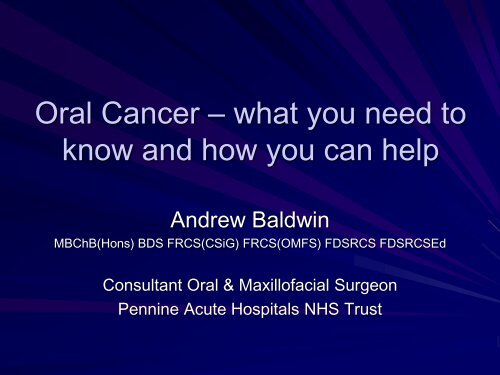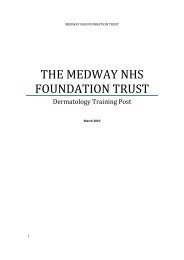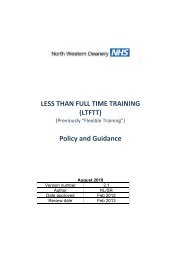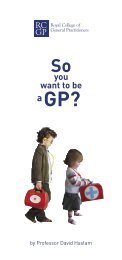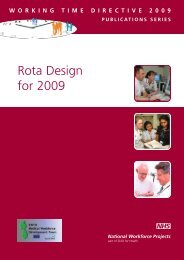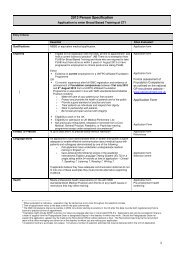Oral Cancer â what you need to know and how you can help
Oral Cancer â what you need to know and how you can help
Oral Cancer â what you need to know and how you can help
- No tags were found...
Create successful ePaper yourself
Turn your PDF publications into a flip-book with our unique Google optimized e-Paper software.
<strong>Oral</strong> <strong>Cancer</strong> – <strong>what</strong> <strong>you</strong> <strong>need</strong> <strong>to</strong><strong>know</strong> <strong>and</strong> <strong>how</strong> <strong>you</strong> <strong>can</strong> <strong>help</strong>Andrew BaldwinMBChB(Hons) BDS FRCS(CSiG) FRCS(OMFS) FDSRCS FDSRCSEdConsultant <strong>Oral</strong> & Maxillofacial SurgeonPennine Acute Hospitals NHS Trust
Who am I?Consultant since 2003Lead Clinician for Head & Neck Oncology (PennineAcute Hospitals Trust, Manchester)Clinical Lecturer University of ManchesterMember Greater Manchester & Cheshire <strong>Cancer</strong>Network Head & Neck Site Specific GroupRegional Advisor Faculty of Dental Surgery RoyalCollege Surgeons of Engl<strong>and</strong>Council Member British Association of <strong>Oral</strong> &Maxillofacial SurgeonsFaculty of Examiners Royal College of Surgeons ofEdinburgh
Aims/OutcomesOutline the incidence, aetiology, diagnosis <strong>and</strong>management of oral <strong>can</strong>cerIndicate <strong>how</strong> oral <strong>can</strong>cer could be classed as asocial diseaseEnsure the dental team <strong>know</strong> <strong>what</strong> <strong>to</strong> look for<strong>and</strong> when <strong>to</strong> refer, <strong>and</strong> underst<strong>and</strong> their role inthe continuing care of patients with oral <strong>can</strong>cerHelp <strong>to</strong> promote an underst<strong>and</strong>ing <strong>and</strong>improvement in general health promotion inprimary dental careDemonstrate reconstructive techniques <strong>and</strong>methods of dental rehabilitationDental nurse roles in oral <strong>can</strong>cer
Prognosis of <strong>Oral</strong> <strong>Cancer</strong>Stage of disease at time of diagnosis &treatment is single most important fac<strong>to</strong>raffecting prognosisSignifi<strong>can</strong>t number of patients still presentat advanced stage at diagnosis
<strong>Oral</strong> <strong>Cancer</strong>15 th most common <strong>can</strong>cer in UK2% of all <strong>can</strong>cers in UK
Mouth, lip <strong>and</strong> oral cavityRegistrations– 5410 (2007); 6539 (2010)– 4097 (66%) men– 2139 (34%) womenDeaths 1851 (2007); 1985 (2010)
<strong>Oral</strong> <strong>Cancer</strong> (Engl<strong>and</strong>)
Survival1996 – 1999– 47% men <strong>and</strong> 55% women survive oral(cavity) <strong>can</strong>cer for 5 years or more
High risk sites70% occur in sump areaOnly 30% surface area of mouth– Floor of mouth– Ventral & lateral <strong>to</strong>ngue– M<strong>and</strong>ibular alveolusDifferent sites in Indian sub-continent– Buccal mucosa common
Increase in <strong>you</strong>nger age groups
<strong>Oral</strong> <strong>Cancer</strong> - Sex, drugs <strong>and</strong> rock& roll?Is this a disease of lifestyle?Can it be avoided?
Risk fac<strong>to</strong>rsMain causes of oral <strong>can</strong>cer have longbeen <strong>know</strong>nMany cases of disease could be prevented– Often regarded as a life-style diseaseSmoking & alcohol - ~ 75% cases(Europe)Nutrition – diet deficient in fruit &vegetables - ~ 10% cases (Europe)
Tobacco & oral <strong>can</strong>cerMain predisposing fac<strong>to</strong>rEither smoking or chewingCurrent smokers have 3-fold increasedrisk of oral <strong>can</strong>cerDose & duration dependentTakes greater than 20 years for risk <strong>to</strong>reduce <strong>to</strong> that of non smokers
Betel quid (pan)Worldwide 200-400 million practice habitComposed of– Leaf of vine, Piper betel, areca nut, slakedlime & spicesAreca nut carcinogenic <strong>to</strong> humansRisk increases with addition of <strong>to</strong>baccoAmong Asian communities in UK,Bangladeshis most likely <strong>to</strong> retain habit ofbetel quid chewing
AlcoholMajor risk fac<strong>to</strong>rRisk increases related <strong>to</strong> intake of alcoholHeavy drinkers & smokers have 38 – 56xrisk of abstainers
AlcoholUK consumption doubled since 1950’sExceeding safe limit– 1988 – 10% women; 26% men– 2002 – 18% women; 30% menHeaviest in 16 – 24 years; likely <strong>to</strong> bingedrink
Ultraviolet lightAffects lip3x more common in menMay be effect of occupation, sun-exposure& smoking
Human Papilloma VirusHPV-16 & HPV-18 (also HPV-31 & -45)Association strongest for oropharynx
HPVRisk fac<strong>to</strong>rs:Often don’t have <strong>know</strong>n risk fac<strong>to</strong>rs eg.– Smoking, alcohol consumption or <strong>to</strong>baccochewingAssociation between HPV related <strong>can</strong>cers:– increased number of sexual partners– increased oral sexual behaviour
Potentially malignant lesionsLeukoplakia– Up <strong>to</strong> 10% transformation over 10 years– May resolve on withdrawal of risk fac<strong>to</strong>rsErythroplakia– Up <strong>to</strong> 70% premalignant or malignantLichen planus– 1% transformation<strong>Oral</strong> submucous fibrosis
Potentially malignant lesionsLichen planusC<strong>and</strong>idal leukoplakia
What <strong>to</strong> look for & when <strong>to</strong> referUlceration of oral mucosa > 3 weeks<strong>Oral</strong> swelling > 3 weeksRed / white patch of oral mucosaHoarseness > 6 weeksDysphagia > 3 weeksUnilateral nasal obstructionUnexplained <strong>to</strong>oth mobility not associated withperiodontal diseaseUnresolving neck masses > 3 weeksCranial neuropathiesOrbital masses
Head <strong>and</strong> Neck<strong>Cancer</strong> Referral Form
2 week wait referral form(suspected head <strong>and</strong> neck <strong>can</strong>cer referral)Always use this form if require urgentreferral for possible malignant, premalignan<strong>to</strong>r suspicious signs/symp<strong>to</strong>msPLEASE DO NOT ABUSE THISREFERRAL PATHWAY
Current management of oral <strong>can</strong>cerSurgery– With or without reconstructionRadiotherapy– Primary radical (+/- with chemotherapy),pos<strong>to</strong>perative or palliativeChemotherapy– Primary radical (+/- with radiotherapy),downstaging prior <strong>to</strong> surgery or palliative
Surgical Treatment:Resultant DefectOften largeAna<strong>to</strong>mically complexFunctional implications
Reconstructive OptionsHow destructive will the surgery be ?What reconstructive techniques are possible ?Likely functional resultAestheticsSpeechSwallowing
Further Management AndRehabilitationSpeech & swallowing therapyPsychological <strong>and</strong> social supportFurther surgery - dental implantsRegular review - early detection ofrecurrenceTerminal care if <strong>need</strong>ed
Problems with treatmentRisks of surgerySide effects of radiotherapy/chemotherapyFunction – speech & swallowingQuality of life
Primary care following treatmentEnsure good preventive measuresGood oral hygieneS&PTopical fluoride applicationHygiene around dental implantsRes<strong>to</strong>rative dentistryReferral for extractions post-radiotherapy
TEAM-WORKING!PARTNERSHIP
Role of the dental nurse in oral<strong>can</strong>cerAware of the risk fac<strong>to</strong>rsAware of potentially malignant lesionsMoni<strong>to</strong>r the mouth with the dentistEnsure awareness of the <strong>need</strong> for urgentreferral <strong>and</strong> pro<strong>to</strong>cols in placeEncourage active management following<strong>can</strong>cer treatmentHealth promotion
Role of the dental nurse in oral<strong>can</strong>cer“Dental Nurses are now able <strong>to</strong> undertake oral healtheducation with the aim of being able <strong>to</strong> promote oralhealth <strong>to</strong> the public <strong>and</strong> patients. Dental Nurses with theappropriate training <strong>can</strong> now perform other duties suchas applying fluoride varnish in a programme overseen bya Consultant or Specialist in Dental Public Health, orusing plaque indices <strong>to</strong> <strong>help</strong> educate patients- both ofwhich Dental Nurses would not have dreamt would bepossible until recently. The possibilities for DentalNurses are exp<strong>and</strong>ing <strong>and</strong> <strong>Oral</strong> Health Education isbecoming an exciting part of the Dental Nurse role.”(The dental nurse network)
Career DevelopmentSpecific educationalor health promotionrole in primary careRole in secondarycare – OMFS deptCertificate in <strong>Oral</strong>Health
Aims of health promotionTo increase awarenessTo reduce incidence of diseaseTo reduce morbidity & mortality associatedboth with treatment <strong>and</strong> natural diseaseprogression
What strategies <strong>can</strong> we develop?Health profession educationClinical moni<strong>to</strong>ring & early treatmentPatient education– Individual or communityNational campaignsMedia involvementVaccinationGene therapy & molecular pathology
Examination of mouth– 58% GDPs regularly examined for mouth<strong>can</strong>cer– GMPs examined in a response <strong>to</strong> complaint ofsorenessLack of confidence in detecting oral <strong>can</strong>cer– GMPs 85% (lack of training cited by 70%)– GDPs 63%
Perceived risk fac<strong>to</strong>rs– Smoking (97%) & alcohol (79%)– Age (76%)– Leukoplakia – GMP (72%) GDP (79%)– Erythroplakia – GMP (22%) GDP (66%)Health promotion questions– Smoking habits - 87% GMPs 19% GDPs– Alcohol consumption - 67% GMPs 3% GDPsGMPs wished for more training– Detection 91%– Prevention 79%
Public awareness of mouth <strong>can</strong>cer2006, BDJ. 384 individuals95% heard of mouth <strong>can</strong>cer (only 56% in1999 in similar study)Tobacco & mouth <strong>can</strong>cer– 85% aware of smoking link– 80% aware of chewing link
Public awareness of mouth <strong>can</strong>cerBUT only– 20% link between alcohol & oral <strong>can</strong>cer– 30% aware of white patches as potentialproblem– those at highest risk of condition had least<strong>know</strong>ledge & less likely <strong>to</strong> recognise earlysigns of disease
Education in the communityIf possible, feed information before habitscommenceAim at school childrenDifficulties– Peer pressure– Cooperation from establishments– What age <strong>to</strong> start?– How graphic do we make the warning?– Attitudes of parents
Sex EducationHPV is the most prevalent STD50-60% US college-aged women have HPV(only 10% have <strong>can</strong>cer-causing strains) – (2004)55% teenagers admitted <strong>to</strong> engaging in oralsexual acts60% of surveyed college students do not equateoral-genital contact with sex
The Future - VaccinationVaccine for HPV recently introduced forgirlsActs against HPV 6, 11, 16 & 18? Give <strong>to</strong> whole population for risk of HPV-16 & HPV-18 induced oral <strong>can</strong>cer?Prevents– Spread of virus– Development of disease
BMJ – January 2010
The Future - VaccinationDr Nigel Carter, chief executive British DentalHealth Foundation (July 2009)– “Mouth <strong>can</strong>cer killing more people than cervical<strong>can</strong>cer <strong>and</strong> testicular <strong>can</strong>cer combined”– “By exp<strong>and</strong>ing its HPV vaccination programme <strong>to</strong>include boys as well as girls, the government wouldbe able <strong>to</strong> address the problem of rising HPV-relatedmouth <strong>can</strong>cer deaths in a simple, fair <strong>and</strong> effectivemanner
The Future - Molecular PathologyAs yet no absolute molecular test whichwill predict transformationStill very much in the research stages
ConclusionsIdentifiable aetiologiesLargely preventable diseaseHigh mortality & morbidityOpportunistic screening in practice possibleMedia & national campaignsDevelopment of reliable screening <strong>to</strong>olsVaccinationMolecular markersEarly hard-hitting intervention <strong>to</strong> prevent uptakeof harmful habits


